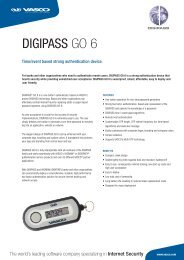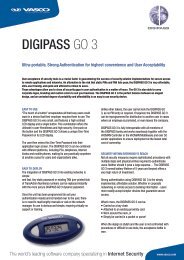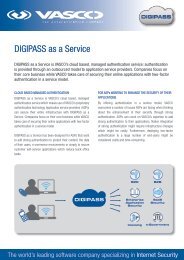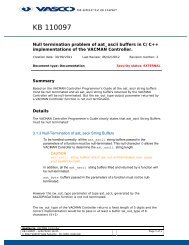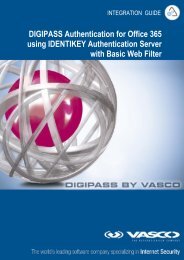Digipass Plug-In for SBR Administrator Reference - Vasco
Digipass Plug-In for SBR Administrator Reference - Vasco
Digipass Plug-In for SBR Administrator Reference - Vasco
Create successful ePaper yourself
Turn your PDF publications into a flip-book with our unique Google optimized e-Paper software.
<strong>Digipass</strong> <strong>Plug</strong>-<strong>In</strong> <strong>for</strong> <strong>SBR</strong> <strong>Administrator</strong> <strong>Reference</strong> ODBC Database<br />
Table vdsName<br />
vdsUser user_table<br />
vdsUserAttr user_attr_table<br />
vds<strong>Digipass</strong> dp_table<br />
vdsDPApplication dpappl_table<br />
vdsPolicy policy_table<br />
vdsComponent comp_table<br />
vdsBackEnd backend_table<br />
vdsDomain domain_table<br />
vdsOrgUnit org_table<br />
3.7 Database Connection Handling<br />
The <strong>SBR</strong> <strong>Plug</strong>-<strong>In</strong> can be configured with a few settings that control the connection to the<br />
database. These settings can be found in the <strong>SBR</strong> <strong>Plug</strong>-<strong>In</strong> Configuration GUI.<br />
3.7.1 Multiple Data Sources<br />
It is possible to make more than one database available to the <strong>SBR</strong> <strong>Plug</strong>-<strong>In</strong> by creating<br />
additional databases and corresponding ODBC data sources. The additional database(s) can be<br />
used <strong>for</strong> redundancy and/or simple load sharing.<br />
If this is done, it is critical that the second and subsequent databases are synchronized with<br />
the first database. You will have to use the methods available to your database type, according<br />
to the database vendor's instructions. Typical methods include mirroring, shadow databases<br />
and instantaneous replication.<br />
Simply by configuring a second data source, if all connections to the main data source fail and<br />
cannot be reopened, the <strong>SBR</strong> <strong>Plug</strong>-<strong>In</strong> will open connections to the second data source.<br />
Similarly, a third data source can be used when the first and second are both unavailable.<br />
3.7.2 Max. Connections<br />
There is a configurable limit on the number of connections to the data source that the <strong>SBR</strong><br />
<strong>Plug</strong>-<strong>In</strong> will have open at one time. This will prevent too many connections being opened to the<br />
database in case of peak load. However, each authentication request uses a connection <strong>for</strong> its<br />
duration, so the number of connections effectively limits the number of authentication requests<br />
that can be concurrently executed. It may improve per<strong>for</strong>mance to increase this setting, when<br />
there are a lot of concurrent requests – provided that the database is able to handle the<br />
increased load.<br />
The effect of this setting depends on the characteristics of your ODBC driver and database.<br />
Some ODBC drivers may not open a separate connection to the database <strong>for</strong> each connection<br />
that is made to it; they may set up a 'pool' of connections to the database or they may even<br />
just maintain a single connection.<br />
© 2006 VASCO Data Security <strong>In</strong>c. 53





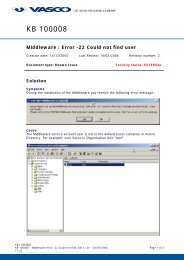

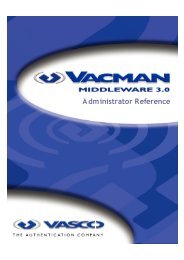
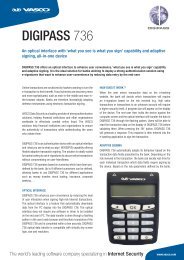
![KB [100006] - Vasco](https://img.yumpu.com/12539350/1/184x260/kb-100006-vasco.jpg?quality=85)

